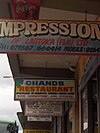Portal:Oceania/Selected article/February, 2009
Indo-Fijians are Fijians who trace their ancestry to India. They number 313,798 (37.6%) (2007 census) out of a total of 827,900 people living on Fiji. They are mostly descended from indentured labourers brought to the islands by Fiji's British colonial rulers between 1879 and 1916 to work on Fiji's sugar cane plantations. These were complemented by the later arrival of Gujarati and Punjabi immigrants. They have adapted to the new environment with changes to their dress, language and culinary habits, although they have maintained their distinct culture.
The Fiji Indians have fought for equal rights, although with only limited success. Many have left Fiji in search of better living conditions and social justice and this exodus has gained pace with the series of coups starting in the late 1980s.
Indo Fijians are concentrated in the so-called Sugar Belt and in cities and towns on the northern and western coasts of Viti Levu and Vanua Levu; their numbers are much scarcer in the south and inland areas. The majority of Indians are Hindi speakers, with large minorities speaking Bhojpuri, Urdu, Tamil, Bihari languages, Gujarati, and Punjabi, among others. Almost all Indians are also fluent in English.

